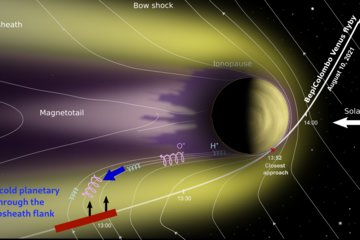All genres
41.
Journal Article
Inflection point in the power spectrum of stellar brightness variations: III. Facular versus spot dominance on stars with known rotation periods. Astronomy and Astrophysics 642, A225 (2020)
42.
Journal Article
Inflection point in the power spectrum of stellar brightness variations: II. The Sun. Astronomy and Astrophysics 636, A69 (2020)
43.
Journal Article
Amplification of Brightness Variability by Active-region Nesting in Solar-like Stars. The Astrophysical Journal Letters 901, L12 (2020)
44.
Journal Article
Erratum: Amplification of Brightness Variability by Active-region Nesting in Solar-like Stars (ApJL (2020) 901 (L12). Astrophysical Journal, Letters 905 (2), L36 (2020)
45.
Journal Article
Connecting measurements of solar and stellar brightness variations. Astronomy and Astrophysics 638, A56 (2020)
46.
Journal Article
Power spectra of solar brightness variations at various inclinations. Astronomy and Astrophysics 636, A43 (2020)
47.
Journal Article
The Sun is less active than other solar-like stars. Science 368 (6490), pp. 518 - 521 (2020)
48.
Journal Article
Inflection point in the power spectrum of stellar brightness variations: I. The model. Astronomy and Astrophysics 633, A32 (2020)
49.
Journal Article
Solar-cycle irradiance variations over the last four billion years. Astronomy and Astrophysics 636, A83 (2020)
50.
Journal Article
Effect of metallicity on the detectability of rotational periods in solar-like stars. Astronomy and Astrophysics 634, L9 (2020)
51.
Journal Article
Power spectrum of turbulent convection in the solar photosphere. Astronomy and Astrophysics 644, A44 (2020)
52.
Journal Article
The dimmest state of the Sun. Geophysical Research Letters 47 (19), e2020GL090243 (2020)
53.
Journal Article
Solar-type Stars Observed by LAMOST and Kepler. The Astrophysical Journal Letters 894 (1), L11 (2020)
54.
Journal Article
Opacity distribution functions for stellar spectra synthesis. Astronomy and Astrophysics 627, A157 (2019)
55.
Journal Article
Transition from spot to faculae domination: An alternate explanation for the dearth of intermediate Kepler rotation periods. Astronomy and Astrophysics 621, A21 (2019)
56.
Journal Article
Readdressing the UV solar variability with SATIRE-S: non-LTE effects. Astronomy and Astrophysics 631, A178 (2019)
57.
Journal Article
Response of Solar Irradiance to Sunspot-area Variations. The Astrophysical Journal 853 (2), 197 (2018)
58.
Journal Article
Revised historical solar irradiance forcing. Astronomy and Astrophysics 615, A85 (2018)
59.
Journal Article
Forward modelling of brightness variations in Sun-like stars: I. Emergence and surface transport of magnetic flux. Astronomy and Astrophysics 620, A177 (2018)
60.
Journal Article
The Influence of Metallicity on Stellar Differential Rotation and Magnetic Activity. The Astrophysical Journal 852 (1), 46 (2018)











